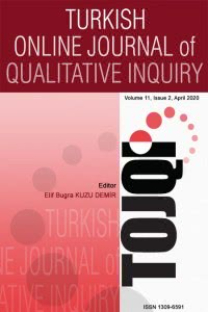The Foreign Language Classroom is Like an AirplaneMetaphorical Conceptualizations of Teachers' Beliefs
Yabancı Dil Sınıfı Bir Yolcu Uçağına BenziyorÖğretmen İnançlarının Metaforik Kavramsallaştırmaları
___
- Akyel, A. (2000). Collaboration to explore teaching: A case study report. TESL Canada Journal, 18(1), 58-74.
- Altan, M. Z. (2012). Pre-service EFL teachers beliefs about foreign language learning. European Journal of Teacher Education, 35(4), 481-493.
- Berliner, D. C. (1990). If the metaphor fits, why not wear it? The teacher as executive. Theory into Practice, 29(2), 85-93.
- Borg, S. (2003). Teacher cognition in language teaching: A review of research on what language teachers think, know, believe, and do. Language Teaching, 36(02), 81-109.
- Borg, M. (2004). The apprenticeship of observation. ELT Journal, 58(3), 274-276. Bullough, R. V. (1991). Exploring personal teaching metaphors in pre-service teacher education. Journal of Teacher Education, 42(1), 43-51.
- Bullough, R. V., & Stokes, D. K. (1994). Analyzing personal teaching metaphors in pre- service teacher education as a means for encouraging professional development. American Educational Research Journal, 31(1), 197-224.
- Cameron, L., & Low, G. (1999). Metaphor. Language Teaching, 33, 7796. Caner, M., Subasi, G., & Kara, S. (2010). Teachers' beliefs on foreign language teaching practices in early phases of primary education: A case study. Turkish Online Journal of Qualitative Inquiry[TOJQI], 1(1), 62-76.
- De Guerrero, M., & Villamil, O. S. (2000). Exploring ESL teachers' roles through metaphor analysis. TESOL Quarterly, 34(2), 341-351.
- De Guerrero, M. C., & Villamil, O. S. (2002). Metaphorical conceptualizations of ESL teaching and learning. Language Teaching Research, 6(2), 95-120.
- Farrell, T. S. C. (2006). The teacher is an octopus: Uncovering pre-service English language teachers prior beliefs through metaphor analysis. RELC Journal, 37(2), 236-248.
- Inceçay, G. (2011). Effects of learning beliefs of pre-service teachers at an English as a foreign language certificate program on their practice teaching. TOJQI, 2(4), 29-38.
- Lakoff, G., & Johnson, M. (1980). The metaphorical structure of the human conceptual system. Cognitive Science, 4(2), 195-208.
- Lin, W. C., Shein, P. P., & Yang, S. C. (2012). Exploring personal EFL teaching metaphors in pre-service teacher education. English Teaching: Practice and Critique, 11(1), 183- 199.
- Lortie, D. C. (1975). Schoolteacher: A sociological study. Chicago: University of Chicago Press. Mahlios, M., & Maxson, M. (1998). Metaphors as structures for elementary and secondary preservice teachers thinking. International Journal of Educational Research, 29(3), 227-240.
- Mahlios, M., Shaw, D. M., & Barry, A. (2010). Making sense of teaching through metaphors: A review across three studies. Teachers and Teaching: Theory and practice, 16(1), 49- 71.
- Marshall, H. H. (1990). Metaphor as an instructional tool in encouraging student teacher reflection. Theory into Practice, 29(2), 128-132.
- Mattheoudakis, M. (2007). Tracking changes in pre-service EFL teacher beliefs in Greece: A longitudinal study. Teaching and Teacher Education, 23(8), 1272-1288.
- Miles, M. B. & Huberman, A. M. (1994). Qualitative Data Analysis: An Expanded Sourcebook. California: Sage. Nikitina, L., & Furuoka, F. (2008a). A language teacher is like . Examining Malaysian students perceptions of language teachers through metaphor analysis. Electronic Journal of Foreign Language Teaching, 5(2), 192-205.
- Nikitina, L., & Furuoka, F. (2008b). Measuring metaphors: A factor analysis of students conceptions of language teachers. Metaphor.de, 15, 161-180.
- Oxford, R. L., Tomlinson, S., Barcelos, A., Harrington, C., Lavine, R. Z., Saleh, A., & Longhini, A. (1998). Clashing metaphors about classroom teachers: Toward a systematic typology for the language teaching field. System, 26(1), 3-50.
- Pinnegar, S., Mangelson, J., Reed, M., & Groves, S. (2011). Exploring pre-service teachers metaphor plotlines. Teaching and Teacher Education, 27(3), 639-647.
- Reeder, S., Utley, J., & Cassel, D. (2009). Using metaphors as a tool for examining pre- service elementary teachers' beliefs about mathematics teaching and learning. School Science and Mathematics, 109(5), 290-297.
- Roberts, J. (1998). Language teacher education. London: Arnold. Saban, A. (2010). Prospective teachers' metaphorical conceptualizations of learner. Teaching and Teacher Education, 26(2), 290-305.
- Saban, A., Kocbeker, B. N., & Saban, A. (2007). Prospective teachers' conceptions of teaching and learning revealed through metaphor analysis. Learning and Instruction, 17(2), 123-139.
- Shaw, D. M., Barry, A., & Mahlios, M. (2008). Pre-service teachers' metaphors of teaching in relation to literacy beliefs. Teachers and Teaching: Theory and Practice, 14(1), 35-50.
- Stofflett, R. (1996). Metaphor development by secondary teachers enrolled in graduate teacher education. Teaching and Teacher Education, 12(6), 577-589.
- Thomas, L., & Beauchamp, C. (2011). Understanding new teachers professional identities through metaphor. Teaching and Teacher Education, 27(4), 762-769.
- Wan, W., Low, G. D., & Li, M. (2011). From students' and teachers' perspectives: Metaphor analysis of beliefs about EFL teachers' roles. System, 39(3), 403-415. Warford, M. K., & Reeves, J. (2003). Falling into it: Novice TESOL teacher thinking. Teachers and Teaching: Theory and Practice, 9(1), 47-65.
- White, B., & Smith, M. W. (1994). Metaphors in English education: Putting things in perspective. English Education, 26(3), 157-176.
- Zapata, G. C., & Lacorte, M. (2007). Pre-service and in-service instructors' metaphorical constructions of second language teachers. Foreign Language Annals, 40(3), 521-534.
- ISSN: 1309-6591
- Yayın Aralığı: 4
- Başlangıç: 2010
- Yayıncı: Prof.Dr. Abdullah Kuzu
Qualities of Ideal Teacher Educators
NİHAL TUNCA GÜÇLÜ, Sonar Alkın ŞAHİN, AYTUNGA OĞUZ, HALİME ÖZGE BAHAR GÜNER
Diminishing the Undesirable Effects of the Computer Games with the Kinect Sensors
Ömer AKDEMİR, ÖMER FARUK VURAL, ÖZGÜR MURAT ÇOLAKOĞLU, Gürkay BİRİNCİ
İdeal Öğretmen Eğitimcilerinde Bulunması Gereken Nitelikler
Halime Özge GÜNER BAHAR, Nihal TUNCA, Aytunga OĞUZ, Sonar Alkın ŞAHİN
Öğretmen Adaylarının Çevrimiçi Tartışma Ortamlarına Yönelik Görüşleri
FERHAT KADİR PALA, MUKADDES ERDEM
Bilgisayar Destekli Hikaye Anlatımı Yöntemi: Alanyazın Araştırması
